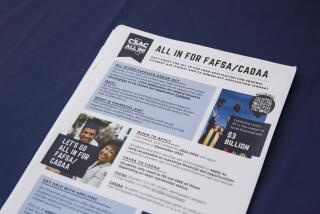Financial Aid Tests Students’ Diligence
- Share via
It’s time for the college-bound to tackle what could be the most economically rewarding test of their lives: financial aid forms.
Tricky and ponderous, these forms test just how well students and their parents can follow directions. Careless errors can cost students a bundle of the $122 billion in work-study awards, grants and low-cost loans that are given out each year to about 14 million students, experts said. And timing is important too.
“Not getting the financial aid forms done fast enough is a big mistake because so many colleges distribute aid on a first-come, first-served basis or only provide aid to those who meet the priority aid deadlines,” said Ben Kaplan, founder of ScholarshipCoach.com, a website that provides financial aid tips.
Aid is given out by many sources: schools, state and federal governments and private donors. Although students can apply for federal aid until the end of the academic year, most state aid, school and private donor scholarships are awarded shortly after so-called priority deadlines pass.
These priority deadlines are set by the colleges and the awarding agencies, so they vary based on the school, the student’s state of residence and the scholarship. Students are advised to find the earliest of their deadlines and make a point of submitting all the forms before that date.
Some of these deadlines are in early February, so aid experts suggest that parents and students get cracking on the financial aid forms that became available this month.
“There are 14 million students applying for financial aid each year. You want to put yourself at the head of that line,” said Martha Holler, a spokeswoman for student lender Sallie Mae in Reston, Va.
It’s also worth noting that although high school juniors do not yet need to fill out aid forms, they should be getting familiar with financial aid rules. The reason, Kaplan said, is that 2005 will be their “base year” for aid. The income the student and the parents earn this year will have a big effect on how much aid the student can qualify for in 2006.
Many four-year universities set aside aid money for continuing students based on the amount of aid these students received in their freshman year, so that base year can affect aid for the students’ entire college careers, added Kaplan, who personally won $90,000 in college scholarships.
Aid is typically based on financial need, so earning less can mean more in loans and scholarships. But it’s foolish to try to earn less in a base aid year -- having more money is always better than having less, regardless of the effect on aid, Kaplan noted.
You can, however, avoid triggering investment profit during this year, he said, by not cashing stock options or trading stock held at a profit. Even one-time paydays will decrease the child’s aid eligibility but make the family no richer.
For those who do own stocks, keep in mind that investment accounts are listed on aid forms at current market value. Whether those assets are held at a profit or loss makes no difference, unless stock is sold during the year and the family records investment income from the sale. In these cases, the asset is still worth the same amount, but the family’s income shows a one-time boost -- effectively counting the same asset twice, Kaplan noted. Worse yet, income hurts aid eligibility more than assets, so selling shares at a profit can deal a significant blow.
Here are a few tips on getting aid.
Get the forms: Every college-bound high school senior and others planning to start college next year should fill out the Free Application for Federal Student Aid, better known as the FAFSA. It can be completed online at www.fafsa.ed.gov. Filling the form out online saves about 10 days in processing time, which can help students make early aid deadlines. The online application also helps students avoid careless errors that can delay applications, Holler of Sallie Mae said. For instance, it will not allow students to skip mandatory questions, nor will it allow them to mistakenly record their most recent birthday, rather than the required birth date -- a mistake that’s remarkably common, she added.
Many private colleges will require a second form, called the CSS Profile, noted Joseph Russo, director of student financial services at University of Notre Dame and coauthor of “How to Save for College” (Princeton Review, 2004). The student’s best bet is to contact all target schools to determine what’s required and where to get the form. Be sure to do it promptly, Russo said. Notre Dame’s priority aid deadline is Feb. 15.
Gather your documents: The FAFSA and the Profile require information about the student’s and the parents’ income and assets. In many cases, the forms ask for income data straight off 2004 tax forms. Those who do not have their tax returns completed can estimate, Holler said. But they will have to revise their applications later in the year to fill in the accurate figures. In addition, parents should gather bank and investment statements as well as trust account statements.
The Profile will also ask about home equity, which can be approximated by subtracting outstanding mortgage debt from the estimated current market value of the home.
Avoid common traps:
* The FAFSA will ask students and parents to fill in their net worth. However, the FAFSA definition of net worth excludes a lot of assets that most people would otherwise include. Do not include any assets held in qualified retirement plans -- that’s 401(k)s, IRAs, 403(b)s, 457 plans and ESOPs. Also exclude home equity, any cash value built up in an insurance policy and cash held in checking and savings accounts. If a family included $100,000 in home equity and retirement assets, it would needlessly cost the student about $5,600 in aid.
* The FAFSA also asks for income information from both parents. However, if the student’s parents are divorced, he or she may exclude information about the noncustodial parent.
* Assets held in 529 college savings plans also can trip up those filling out the FAFSA. That’s because each beneficiary of a 529 savings plan probably has a separate account listed under his or her Social Security number. However, technically the asset belongs to the donor, not the beneficiary. And those who record 529 assets as the beneficiary’s property probably will lose out. Why? Every dollar held in the student’s name will cost that individual 35 cents in aid eligibility. But a dollar held in the parent’s name costs just 5.65 cents in aid eligibility. If Mom and Dad set up the account, make sure the 529 assets are shown as theirs on the FAFSA.
What if the 529 plan was set up by a grandparent or aunt or uncle? The assets in the account should not be listed on the FAFSA. However, some private colleges may ask students to reveal if there is a 529 plan with their name on it, provided by an individual not listed on the form.
* Applicants may be tempted to skip nonmandatory questions, such as how many students the family has in college or in their household, but these questions can boost the child’s eligibility for aid, Holler said. For instance, if the family has three individuals in college, each student’s aid eligibility is enhanced because the formula recognizes that the family’s college funds must be split three ways, she said.
“This is like doing your taxes: It’s not that straightforward,” Kaplan said. “There are a lot of nuances that you really need to know.”
*
(BEGIN TEXT OF INFOBOX)
College costs
Here’s the average total cost of room, board, tuition and fees at public and private four-year colleges for the last 10 years.
*--* Academic year Private Public 1995-96 $17,382 $6,743 1996-97 $18,357 $7,142 1997-98 $19,360 $7,469 1998-99 $20,463 $7,769 1999-00 $21,475 $8,080 2000-01 $22,240 $8,439 2001-02 $23,856 $9,032 2002-03 $24,867 $9,672 2003-04 $26,057 $10,530 2004-05 $27,516 $11,354
*--*
Source: College Board
*
Kathy M. Kristof, author of “Investing 101” and “Taming the Tuition Tiger,” welcomes your comments and suggestions but regrets that she cannot respond individually to letters or phone calls. Write to Personal Finance, Business Section, Los Angeles Times, 202 W. 1st St., Los Angeles, CA 90012, or e-mail [email protected]. For previous columns, visit latimes.com/kristof.
More to Read
Sign up for Essential California
The most important California stories and recommendations in your inbox every morning.
You may occasionally receive promotional content from the Los Angeles Times.










